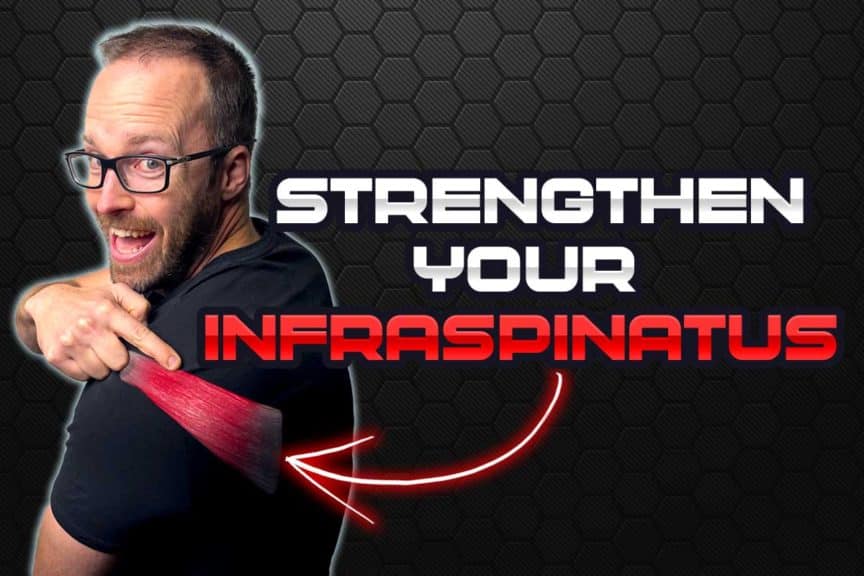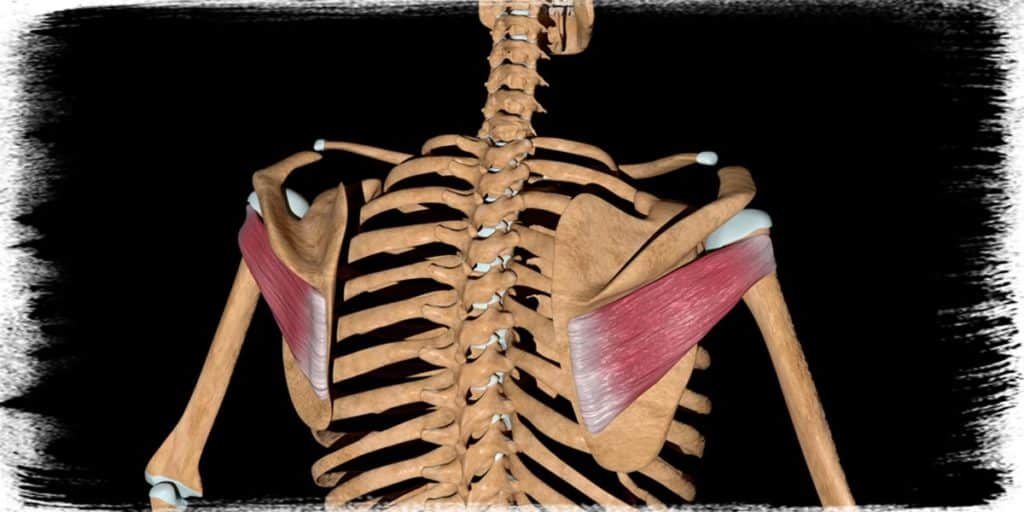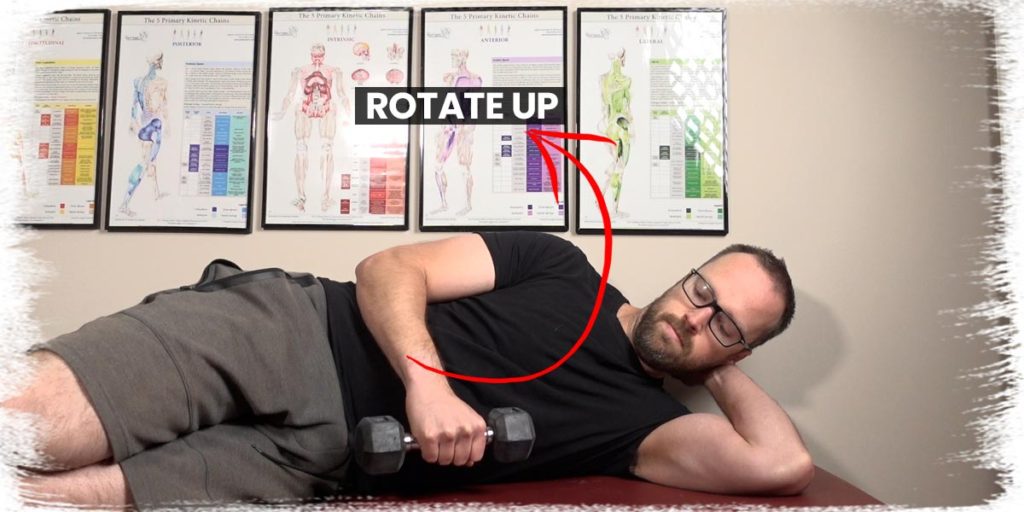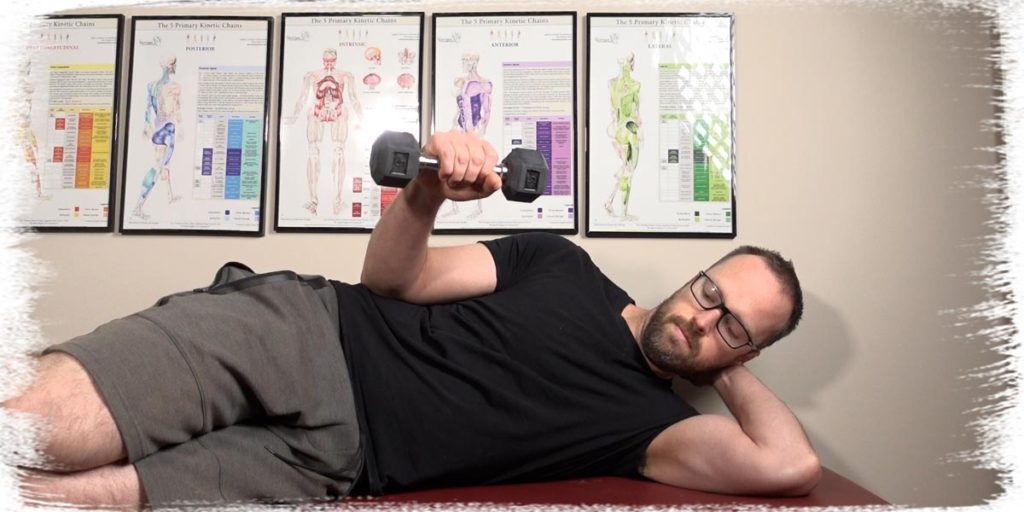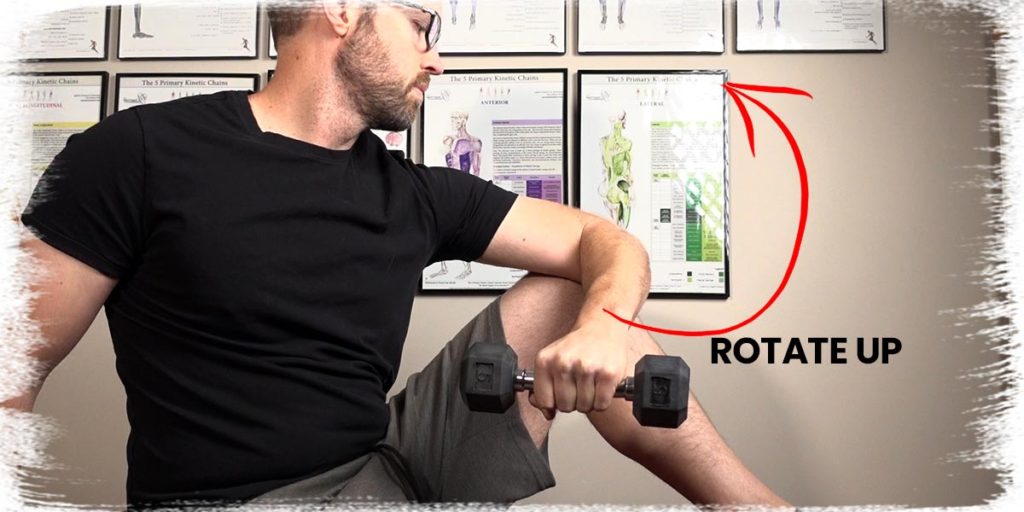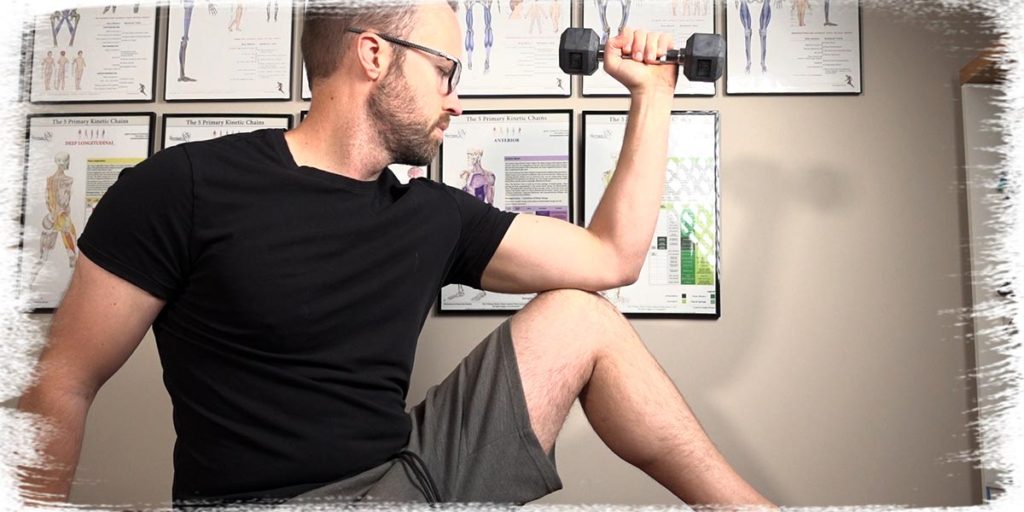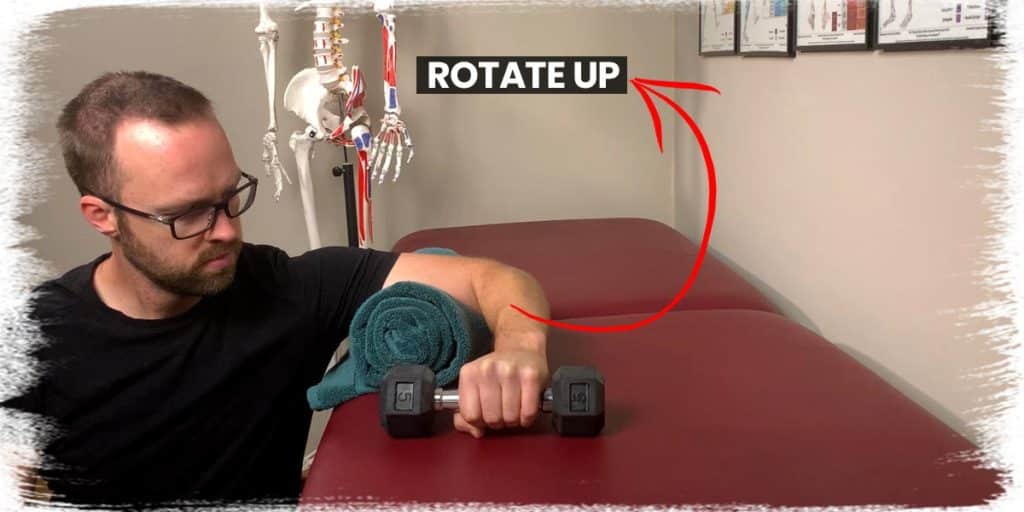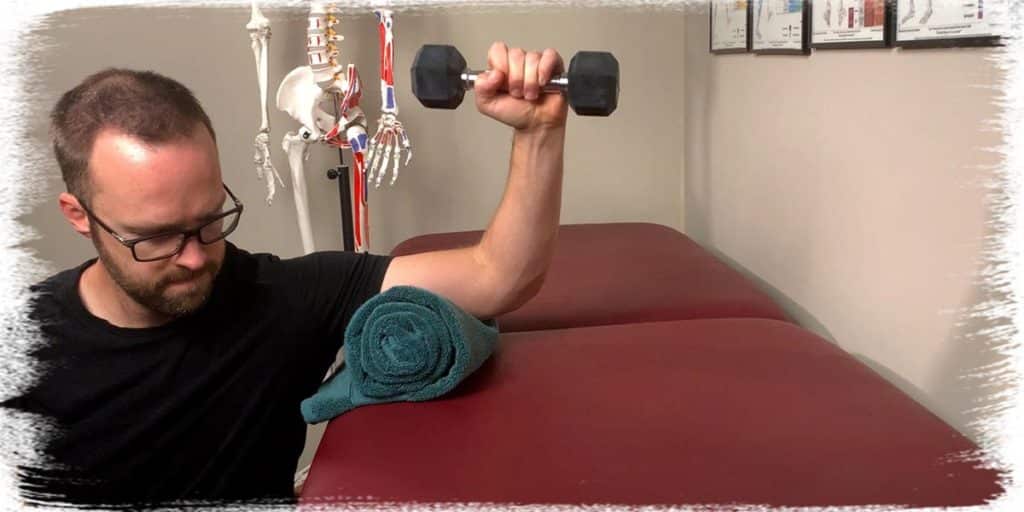Rotator cuff injuries (such as partial tears, tendinopathies, etc.) are the third most common cause of musculoskeletal disability in humans. They can range from being a mild nuisance to an extremely painful and debilitating shoulder condition. Thankfully, resistance training has been shown to have excellent outcomes for many of these rotator cuff issues when done correctly.
If you’re specifically trying to strengthen your infraspinatus muscle, this article will walk you through three very effective exercises that you can do using only a dumbbell.
The best dumbbell exercises for the infraspinatus are:
• Side-lying external rotations
• Knee-propped external rotations
• Table-supported external rotations
These exercises are simple to do and target the muscle to a large extent while minimizing the recruitment of other shoulder muscles.
Related article: Here’s How Often You Should Be Doing Your Physical Therapy Exercises
While there are a seemingly infinite number of exercises and ways to challenge your infraspinatus muscle (to help it heal or prevent injury), using a dumbbell or other small weight is one of the tried-and-true ways to do so.
So, if you want all the details on how to do these exercises effectively and stand the best chance possible with maximal benefits, keep on reading!
ARTICLE OVERVIEW (QUICK LINKS)
Click/tap any of the following headlines to instantly jump to that section for the article!
• Quick anatomy: the role of the infraspinatus
• Selection: the right amount of weight for these exercises
• Exercise 1: Side-lying external rotations
• Exercise 2: Knee-propped external rotations
• Exercise 3: Table-supported external rotations
• Final thoughts
Disclaimer: While I am a physical therapist, I am not YOUR physical therapist. As a result, I cannot tell you whether or not any treatments or training methodologies mentioned on this website or in this article may or may not be appropriate for you, including performing infraspinatus exercises. By following any information within this post, you are doing so at your own risk. You are advised to seek appropriate medical advice for any pain you may be experiencing.
Quick anatomy: the role of the infraspinatus
The infraspinatus is one of four muscles that form the rotator cuff. These four muscles work as a team to help guide and fine-tune movements of the shoulder. They are smaller and more delicate muscles, which is perhaps one of the reasons why they can become torn, overused and otherwise painful as we go through life.
The primary role of the infraspinatus is to help with a movement of the shoulder known as external rotation (sometimes called lateral rotation). This movement refers to your humerus (upper arm bone) rotating outwards (away from your body). It is a very important movement for the shoulder to do. As such, it provides the infraspinatus with a critical role to play in overall shoulder function and health.
Selection: the right amount of weight for these exercises
Whether your shoulder needs some rehab or is already healthy and you’re just looking to keep it that way, it’s important to know that these are not the muscles you want to take to their limits with lifting super heavy weights/maximal loads. Save those types of maximum-effort exercises for squats, bench press, etc. To do so with your rotator cuff muscles is likely asking for trouble.
Pro tip: If you don’t have a dumbbell, try using a can of soup or filling a water bottle. Since most people don’t need much weight for these following exercises, it’s pretty easy to find something else to hold onto that offers the appropriate amount of resistance.
The rotator cuff muscles are quite delicate in comparison, so you need to know how to use enough weight to effectively stimulate the muscle but not so much that you risk irritating or injuring it altogether.
Selecting weight for rehabilitative exercise
The amount of weight you use for these exercises will largely depend on the overall condition or status of your infraspinatus muscle, your shoulder in general, and even your overall health.
As a very general rule, you will want to use a weight that produces fatigue in the muscle at around ten to twelve repetitions. The weight should be heavy enough to allow you to complete all of the repetitions with perfect form, but it should produce enough fatigue that by the last repetition or two, it’s a challenge to maintain that good form.
Related article: The ABSOLUTE Best Exercise for Subscapularis Strengthening: Here’s How
A very minimal amount of discomfort (around 2/10 on a 10-point pain scale) is acceptable when performing the exercise, provided that the pain does not get any worse at any point in time throughout the exercise. The pain should be a dull, achy pain in its nature. If it is a sharp pain, it’s best to discontinue the exercise.
Selecting weight for general strengthening or injury prevention
If you’re looking to perform the following exercises for injury prevention or for general strengthening of the infraspinatus muscle, you can likely go a little bit heavier than someone who needs to perform these exercises as part of a rehabilitative regimen.
General strengthening repetition ranges for these exercises tend to be in the range of 8 – 10 reps. However, this is a very general rule. If you have good form and control with the exercise, you may be able to use a weight that’s heavy enough for a 6 repetition range. I tend to keep my repetitions with these exercises in the 8 -10 range, as I’ve learned to listen to my body enough over the years to know that this seems to be the sweet spot for my rotator cuff muscles.
Exercise 1: side-lying external rotations
The side-lying external rotation is the close relative of the very traditional standing external rotation that’s often performed with a Theraband. Neither one of these exercises is better than the other, per se; rather, there are times where it’s easier to perform the dumbbell version, such as when you don’t have any Theraband or exercise bands in general.
To perform the exercise:
- Lay on your side with the arm you’re about to exercise, facing up.
- Use a pillow or your arm to support your neck and keep it in a comfortable position.
- Bend your elbow to 90 degrees and keep it pinned to your side
- Make sure your shoulder blade is not pulled back towards your spine (keep it in a neutral position)
- With the weight in your hand, rotate your arm upwards. The axis of rotation should be the tip of your elbow.
- Do not let your shoulder blade move at all (this will feel like it shortens your range of motion, but it will really force the infraspinatus to work extra hard).
- Slowly return to the starting position and repeat for desired repetitions and sets.
Exercise 2: Knee-propped external rotations
The knee-propped external rotation is a great exercise to perform for the infraspinatus since it produces external rotation while the shoulder is resting in a flexed position (resulting in a more stretched position for the infraspinatus). As a result, it can provide a different stimulus to the infraspinatus muscle since the muscle must produce its contraction from a more stretched position than when compared to the more traditional position often seen with the side-lying position.
To perform the exercise:
- Sit on a surface that allows you to bend your knee and rest it on the same surface you’re sitting on (the same side as the shoulder you’re going to exercise).
- Rest the back of your elbow on top of your knee. (You can use a pillow or towel if you’d like a bit of padding to make it more comfortable on your arm.)
- Starting with your forearm in a vertical position, allow your arm to slowly rotate downwards. Your upper arm should stay relatively motionless (the axis of rotation should be around the tip of your elbow).
- Once you’ve gone as far as you can, pull your arm back upwards to the starting position.
- Repeat for your desired number of repetitions and sets.
Exercise 3: Table-supported external rotations
The table-supported external rotation is much like the knee-propped external rotation in that it forces the infraspinatus to produce its contraction. At the same time, the arm is in a different position than simply resting at the side of the body. In this case, we’re keeping the arm in a position known as abduction while the exercise occurs.
It’s important to have your arm rest on a table or supportive surface with this exercise since that allows other muscles around the muscle to “shut off,” permitting us to focus our efforts specifically on the infraspinatus. Often, people will perform this movement while actively holding their arms up in the air. While this isn’t bad, per se, it’s not ideal if the sole intention of the exercise is to isolate and target the infraspinatus as much as possible.
To perform the exercise:
- Sit next to a table or supportive surface that is somewhere around the height of your chest. It doesn’t have to be exact, but somewhere in this range should suffice.
- Use a cushion of some kind underneath your elbow to ensure comfort.
- Start with your forearm pointing directly forwards and then begin to pull it backwards. Your shoulder blade shouldn’t move at all, and the axis of rotation should be the tip of your elbow (everything should spin/rotate around this point).
- Once you’ve gone as far as you can, slowly return to the starting position and repeat for your desired number of repetitions and sets.
Related article: Motivate Yourself to Workout at Home: Pro Tips to Get Fired Up!
Final thoughts
There are plenty of ways to strengthen your infraspinatus, be it for injury rehabilitation or injury prevention. In either case, a dumbbell is one of the tried-and-true ways to make this happen. But remember, it doesn’t have to be a dumbbell — any object you can hold onto that offers the appropriate amount of resistance will do the trick.
These three exercises all work by challenging the infraspinatus in slightly different ways and have been used in rehabilitative and gym-based settings for decades. So, now that you know how to perform them, give them a try and give your rotator cuff some love!
References:
1. Longo UG, Berton A, Papapietro N, Maffulli N, Denaro V. Epidemiology, genetics and biological factors of rotator cuff tears. Rotator Cuff Tear. 2012;57:1-9.2. McCarrick MJ, Kemp JG. The effect of strength training and reduced training on rotator cuff musculature. Clin Biomech. 2000;15:S42-S45.
2. McCarrick MJ, Kemp JG. The effect of strength training and reduced training on rotator cuff musculature. Clin Biomech. 2000;15:S42-S45.

Hi! I’m Jim Wittstrom, PT, DPT, CSCS, Pn1.
I am a physical therapist who is passionate about all things pertaining to strength & conditioning, human movement, injury prevention and rehabilitation. I created StrengthResurgence.com in order to help others become stronger and healthier. I also love helping aspiring students and therapists fulfill their dreams of becoming successful in school and within their clinical PT practice. Thanks for checking out my site!

